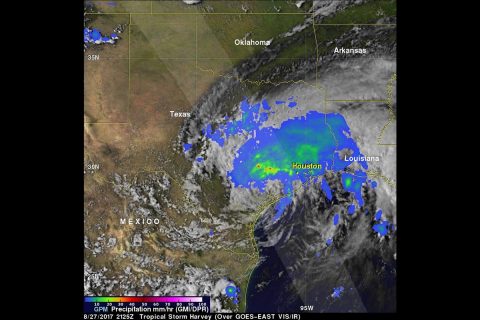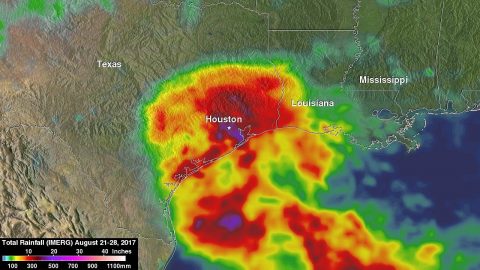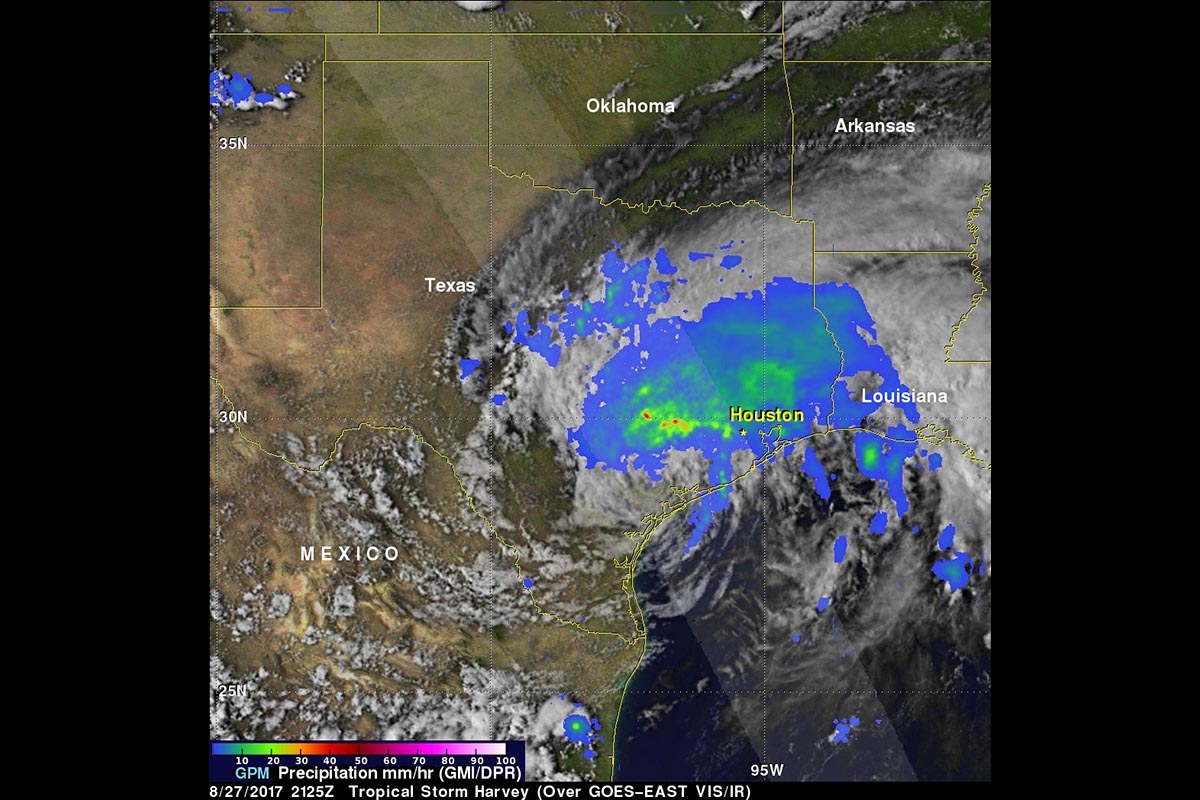Written by Rob Gutro / Steve Lang
NASA’s Goddard Space Flight Center
 Greenbelt, MD – At NASA’s Goddard Space Flight Center in Greenbelt, Maryland, an analysis of Hurricane Harvey’s tremendous rainfall was created using eight days of satellite data.
Greenbelt, MD – At NASA’s Goddard Space Flight Center in Greenbelt, Maryland, an analysis of Hurricane Harvey’s tremendous rainfall was created using eight days of satellite data.
NASA’s Integrated Multi-satellitE Retrievals for GPM or IMERG product is used to make estimates of precipitation from a combination of space-borne passive microwave sensors, including the GMI microwave sensor onboard the Global Precipitation Measurement satellite GPM core satellite, and geostationary IR (infrared) data.

The result has been widespread, massive flooding across the region and brings back memories of Tropical Storm Allison, which dropped up to 40 inches of rain in Texas back in 2001 and caused devastating flooding in the Houston area.
More Rainfall Expected

The National Hurricane Center (NHC) noted at 1:00pm CDT on August 28th, “Harvey is expected to produce additional rainfall accumulations of 15 to 25 inches through Friday over the upper Texas coast and into southwestern Louisiana. Isolated storm totals may reach 50 inches over the upper Texas coast, including the Houston/Galveston metropolitan area.
These rains are currently producing catastrophic and life-threatening flooding over large portions of southeastern Texas.”
Warnings In Place at 1 p.m. CDT, Aug. 28th
A Tropical Storm Warning remained in effect from Mesquite Bay to Cameron, Texas and a Tropical Storm Watch is in effect from east of Cameron to Intracoastal City, Louisiana.
The National Hurricane Center said “Catastrophic and life-threatening flooding continues in southeastern Texas. Please see warnings and other products issued by your local National Weather Service office for additional information on this life-threatening situation.”
Location of Harvey at 1 p.m. CDT, Aug. 28th
At 1:00pm CDT (1800 UTC), the center of Tropical Storm Harvey was located near 28.6 degrees north latitude and 95.8 degrees west longitude.
Harvey is currently drifting erratically toward the east-southeast, and a slow motion toward the southeast is expected later today through tonight. A gradual turn toward the northeast and a continued slow forward speed are expected Tuesday and Tuesday night. On the forecast track, the center of Harvey is expected to be just offshore of the middle and upper coasts of Texas through Tuesday night.
Maximum sustained winds are near 40 mph (65 kph) with higher gusts. Some slow intensification is possible during the next 48 hours. The minimum central pressure estimated from surface observations along the Texas coast is 998 millibars.
Harvey’s History
Harvey began on August 17th as a weak tropical storm about 250 miles (~400 km) east of Barbados in the Leeward Islands. Over the next two days, Harvey continued moving steadily westward passing through the Leeward Islands as a still weak tropical storm and entered into the east central Caribbean.
On August 19th, Harvey succumbed to the effects of northeasterly wind shear over the central Caribbean and lost its cyclonic circulation and weakened back into a tropical wave. The remnants of what was once Harvey then passed over the Yucatan Peninsula and into the Bay of Campeche.
Typically, it is hard for a system to reform after dissipating as well as after passing over land. However, the environmental conditions were favorable for development and the water temperatures in the Gulf of Mexico very warm. This allowed Harvey first to reform into a tropical depression on the morning of the August 23rd then strengthen back to a tropical storm later that evening.Having recovered its structure, Harvey was then able take further advantage of the low wind shear and warm waters and continue to intensify, becoming a hurricane by midday on August 24th and then rapidly intensifying overnight into a Category 2 storm with maximum sustained winds reported at 110 mph (~175 kph) by the National Hurricane Center (NHC) at 15:00 UTC (10:00am CDT) the next morning.
Now moving northwest across the western Gulf and Mexico and headed straight for the central Texas coast, Harvey continued to get stronger during the day on Aug. 25 and reached its peak intensity as a Category 4 storm with sustained winds of 130 mph (215 kph) at 6:00 pm CDT according to NHC.
Harvey maintained this intensity until it made landfall later that evening at around 10:00pm CDT as a Category 4 hurricane near Rockport, Texas, about 30 miles east-northeast of Corpus Christi. After making landfall, Harvey weakened and its winds decreased back down to tropical storm intensity by 1:00pm CDT the next day on August 26th; however, as had been forecast, the steering currents collapsed, bringing the storm to a near standstill just inland from the Texas Gulf Coast and setting the stage for a catastrophic flooding event.
GPM Measured Harvey’s Rainfall Rates on Aug. 27
On August 27th, GPM captured rainfall data on Harvey at 21:25 UTC (4:25pm CDT) as it was meandering slowly southeast at just 2 mph (~4 kph) near Victoria, Texas west of Houston. Data from GPM’s GMI microwave imagery and dual-frequency precipitation radar or DPR was overlaid on enhanced visible/infrared image from NOAA’s GOES East satellite.
The image, created at NASA Goddard showed Harvey’s cyclonic circulation was still quite evident in the visible/infrared clouds, but GPM showed that the rainfall pattern was highly asymmetric with the bulk of the rain located north and east of the center.
A broad area of moderate rain was evident from near Galveston Bay to north of Houston and back well to the west. Within that area were embedded areas of heavy rain. The peak estimated rain rate from GPM at the time of this overpass was 96 mm/hour (~3.77 inches per hour).
About IMERG
The Integrated Multi-satellitE Retrievals for GPM (IMERG) is a unified U.S. algorithm that provides a multi-satellite precipitation product. IMERG is run twice in near-real time with the “early” multi-satellite product being created at about 4 hours after observation time and a “late” multi-satellite product is provided at about 12 hours after observation time. IMERG rainfall totals have been adjusted to reflect observed values in other similar extreme rainfall events.
With Harvey’s circulation still reaching out over the Gulf, the storm is able to draw in a continuous supply of warm moist air to sustain the large amount of rain it is producing.
For updated forecasts on Harvey, visit: www.nhc.noaa.gov
For more information about GPM, visit: www.nasa.gov/gpm.



